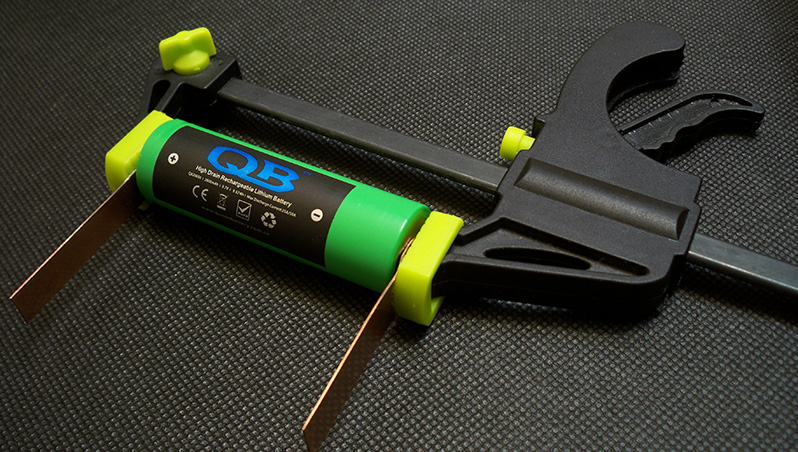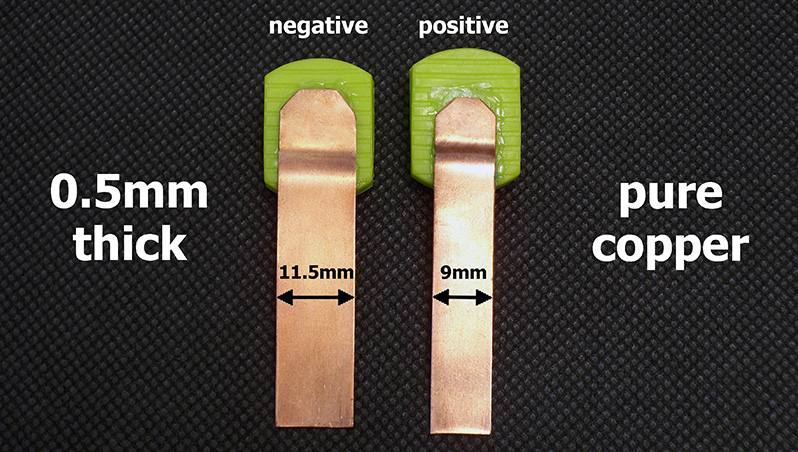thunderheart
Member
- Joined
- Apr 4, 2018
- Messages
- 276
I've previously testedSanyo UR18650ZTAand this time i've got anoother 4.35V cell - LG E1.

The battery was bought from my reliable supplier (Queen Battery) and tested withZKETECH EBC-A20and a self-made battery holder. It's a PC-connected battery tester supporting 4-wire measuring and discharging at up to 20A.

I've used version 3.0 of my battery holder based on 0.5mm thick pure copper terminals


I've followed all the prescriptions of theIEC61960-2003standard concerning battery's capacity measurement. Before each discharging cycle each battery was charged at standard charge current mentioned in its datasheet to charge end voltage. Before each discharging or charging i've held a 1-1.5hrs pause. The environment temperature was 23.0-24.5C. To be sure in results i've done each testminimum twice(usually 3-4 times).
LG ICR18650 E1
The cell is marked as LGABE11865 0247I048AB.

The main specs from LG E1datasheet:
Nominal energy:12.0Wh
Minimum energy:11.6Wh
Nominal voltage:3.75V
Standard charge current:0.93A (0.3C)
Maximum charge current:1.55A (0.5C)
Charge cut-off current:50mA (100mA used)
Charge end voltage:4.35V
Max. continuous discharge current:4.65A (1.5C)
Discharge cut-off voltage:2.75V
AC impedance at 1KHz:?70m?
Max weight:49g
Measured initial DC IR at 3.1A in fully charged condition was 563m?
Measured weight of the tested cell was 47.52g

Capacity test results
At 4.35V charge:

The nominal energy at 0.2C doesn't reach 12Wh declared and the capacity is a bit higher than 3000mAh. Look at the 5A curve - it's really a heavy load for this guy. I'd not discharge it at more than 2A.
At 4.20V charge:

At 4.2V charge the capacity goes down to 2600mAh. The character of curves remains the same, just the numbers get lower.
COMPARISON
Let's check how much we lose by using 4.2V charge instead of 4.35V.
At 0.2C/0.62A:

Here we lose 13% in capacity and 14% in energy.
At 2A discharge:

The same 13 and 14%.
At 5A:

We lose 12% in capacity and 13% in energy.
So in general we lose about 13-14%.
LG E1 didn't show any fantastic results. It's real capacity appears to be about 3000mAh and 5A discharge seems to be too much for this cell. E1 could be interesting for those who need a high voltage cell for low drain (up to 2A) applications.
Here is the video version of this review:

Check outmyYouTube channelfor batteries, chargers and other stuff reviews.
I've launchedmy blogwhere you can find all my reviews in one place. Every new test/review will be first published on YouTube and in the blog. I'll be happy to see new subscribers, comments, suggestions and just your thoughts.

The battery was bought from my reliable supplier (Queen Battery) and tested withZKETECH EBC-A20and a self-made battery holder. It's a PC-connected battery tester supporting 4-wire measuring and discharging at up to 20A.

I've used version 3.0 of my battery holder based on 0.5mm thick pure copper terminals


I've followed all the prescriptions of theIEC61960-2003standard concerning battery's capacity measurement. Before each discharging cycle each battery was charged at standard charge current mentioned in its datasheet to charge end voltage. Before each discharging or charging i've held a 1-1.5hrs pause. The environment temperature was 23.0-24.5C. To be sure in results i've done each testminimum twice(usually 3-4 times).
LG ICR18650 E1
The cell is marked as LGABE11865 0247I048AB.

The main specs from LG E1datasheet:
Nominal energy:12.0Wh
Minimum energy:11.6Wh
Nominal voltage:3.75V
Standard charge current:0.93A (0.3C)
Maximum charge current:1.55A (0.5C)
Charge cut-off current:50mA (100mA used)
Charge end voltage:4.35V
Max. continuous discharge current:4.65A (1.5C)
Discharge cut-off voltage:2.75V
AC impedance at 1KHz:?70m?
Max weight:49g
Measured initial DC IR at 3.1A in fully charged condition was 563m?
Measured weight of the tested cell was 47.52g

Capacity test results
At 4.35V charge:

The nominal energy at 0.2C doesn't reach 12Wh declared and the capacity is a bit higher than 3000mAh. Look at the 5A curve - it's really a heavy load for this guy. I'd not discharge it at more than 2A.
At 4.20V charge:

At 4.2V charge the capacity goes down to 2600mAh. The character of curves remains the same, just the numbers get lower.
COMPARISON
Let's check how much we lose by using 4.2V charge instead of 4.35V.
At 0.2C/0.62A:

Here we lose 13% in capacity and 14% in energy.
At 2A discharge:

The same 13 and 14%.
At 5A:

We lose 12% in capacity and 13% in energy.
So in general we lose about 13-14%.
LG E1 didn't show any fantastic results. It's real capacity appears to be about 3000mAh and 5A discharge seems to be too much for this cell. E1 could be interesting for those who need a high voltage cell for low drain (up to 2A) applications.
Here is the video version of this review:

Check outmyYouTube channelfor batteries, chargers and other stuff reviews.
I've launchedmy blogwhere you can find all my reviews in one place. Every new test/review will be first published on YouTube and in the blog. I'll be happy to see new subscribers, comments, suggestions and just your thoughts.



